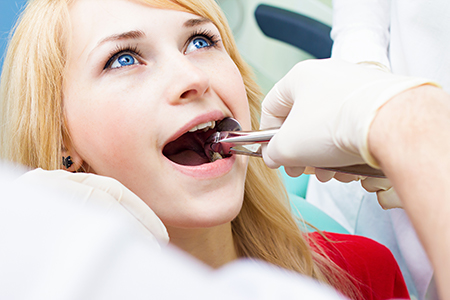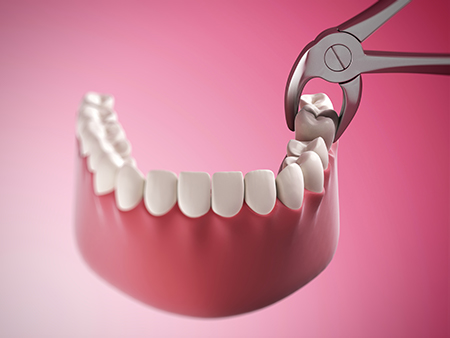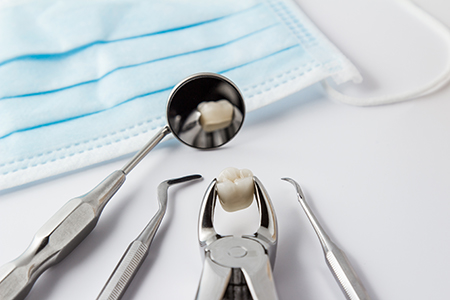
Your dental team will always aim to preserve natural teeth, but there are situations when removing a tooth is the healthiest path forward. Extractions are recommended when a tooth is irreparably damaged, obstructing proper development, or posing a risk to surrounding teeth and tissues. Approaching the decision thoughtfully helps protect long‑term oral function and comfort.
Common scenarios that lead to extraction include persistent infection that cannot be resolved with root canal therapy, teeth that are structurally unsalvageable because of decay or fracture, or primary (baby) teeth that won’t release and block the eruption of permanent teeth. Impacted third molars — commonly called wisdom teeth — may also require removal when they threaten nearby structures or cause recurrent problems.
Every extraction begins with an evaluation designed to weigh the benefits and the alternatives. We combine a clinical exam with imaging when needed to assess root form, bone support, and the tooth’s relationship to adjacent anatomy. This careful planning minimizes surprises and supports a safe, predictable outcome.
Non-restorable baby teeth or teeth delaying permanent eruption
Sometimes a primary tooth refuses to fall out or becomes so compromised that it interferes with the developing bite. If the baby tooth is ankylosed (fused) to bone or severely decayed, extraction can clear the way for proper alignment and growth of the permanent successor.
Permanents with extensive decay or irreversible structural loss
When decay has progressed beyond repair and there isn’t enough healthy tooth to support a restoration, extraction becomes the safest option to prevent ongoing infection or further damage to adjacent teeth and tissues.
Severe fractures that compromise the tooth or root
A tooth with a catastrophic crack or root fracture may not be recoverable. In such cases removal prevents chronic pain and recurrent treatment attempts that would not restore reliable function.
Advanced periodontal disease
Periodontal (gum) disease can progressively destroy the bone and soft tissues that support teeth. When attachment loss leaves a tooth mobile or non-functional, extraction can be part of a plan to restore overall oral health.
Impacted or problematic wisdom teeth
Wisdom teeth often erupt with limited space, becoming impacted or partially erupted and prone to decay and infection. Early removal of troublesome third molars can prevent complications to neighboring teeth and the jaw.
Preparation for orthodontic alignment
In some orthodontic treatment plans, selective extraction is the most effective way to correct crowding and achieve a stable, functional bite. These decisions are made collaboratively with your orthodontist when appropriate.

Preparation is key to a smooth procedure. We begin with a thorough review of your medical history, current medications, and any conditions that could affect healing. If necessary, we coordinate with your physician and take precautions such as altering medications or using prophylactic antibiotics when patient safety calls for it.
Diagnostic imaging — including up-to-date digital radiographs — allows us to study root length and shape, bone density, and the tooth’s proximity to nerves or sinus spaces. With that information we choose the least invasive, most appropriate technique and discuss anesthesia and sedation options to ensure your comfort.
Most extractions are performed under local anesthesia in the dental chair. For anxious patients or more complex cases we offer sedation strategies to reduce stress and improve tolerance. Our goal is to eliminate pain during the procedure, maintain clear communication, and make the experience as calm and efficient as possible.
A simple extraction applies when the tooth is fully visible in the mouth and can be removed using elevators and forceps after adequate numbness is achieved. The technique is straightforward, but it still requires precision to protect surrounding bone and soft tissue.
A surgical extraction is used for teeth that are broken at the gumline, impacted, or have complex root anatomy. This approach may involve a small incision, removal of a bit of bone, or sectioning a tooth to allow safe removal. When a case is particularly complex, we may refer patients to an oral and maxillofacial surgeon who specializes in advanced surgical care.
Throughout either type of procedure we prioritize infection control, controlled techniques to preserve bone, and clear post-operative instructions so you understand what to expect during recovery and when follow-up care will be needed.

Healing after an extraction follows predictable stages: clot formation, soft tissue repair, and gradual bone remodeling. Most patients experience some tenderness and swelling that peaks within the first 48 hours and then subsides. Following clear post-operative directions reduces complications and speeds recovery.
We provide a tailored set of aftercare instructions that reflect the complexity of your procedure and your overall health. These steps cover pain management, swelling control, activity restrictions, and guidance for oral hygiene to protect the surgical site while it heals.
If stitches are placed, they may be absorbable or require removal at a follow-up appointment. We schedule check-ins when needed to confirm healing is progressing normally and to address any questions or concerns that arise during recovery.
Manage initial bleeding
You will be given gauze to bite on immediately after the procedure. Keep steady pressure on the site as instructed; brief, controlled bleeding or oozing is normal for the first day. If bleeding remains heavy after following the guidelines, contact the office.
Protect numb tissues
Until sensation returns, avoid chewing and be cautious not to bite your lip, cheek, or tongue. Numbness typically wears off within a few hours.
Follow medication directions
Antibiotics:
If prescribed, take the full course exactly as directed to reduce infection risk.
Pain medication:
Start pain control as recommended, often before the anesthesia fully wears off, and use over‑the‑counter options unless a prescription is provided.
Allow the clot to stabilize
Do not rinse vigorously, use a straw, or smoke for the first week, as these actions can dislodge the clot and delay healing.
Control swelling
Apply an ice pack to the face in short intervals during the first day to reduce swelling; elevation and rest are also helpful.
Choose gentle nutrition
Soft, cool foods and adequate fluids are encouraged for the first couple of days. Avoid hot, spicy, or carbonated beverages that could irritate the wound.
Maintain cautious oral hygiene
Continue regular brushing but avoid the extraction site for a short period. After 24–48 hours you can gently rinse with a saltwater solution to keep the area clean.
Attend follow-up visits
If sutures were used or your case requires monitoring, keep your scheduled follow-up so we can confirm proper healing and discuss replacement options if appropriate.
If you notice persistent heavy bleeding, worsening pain, increasing swelling beyond the expected timeframe, or any signs of infection, contact our office for guidance.

We pair conservative treatment philosophy with modern surgical technique to deliver care that is both careful and effective. When extraction is indicated, we focus on preserving bone and soft tissue whenever possible to make future restorative options — such as bridges, dentures, or implants — more predictable.
Suss Dental Group emphasizes transparent communication and individualized treatment planning. We will explain why extraction is recommended, outline what to expect during recovery, and review tooth replacement options only when you are ready to consider them. Our approach is patient-centered and clinically driven.
When a case is straightforward we perform the procedure in our office; for more complex surgical needs, we collaborate with trusted specialists. This continuity of care helps ensure that every patient receives the appropriate level of expertise for their unique situation.
Extractions are common, well-understood procedures that can protect comfort and oral health when a tooth cannot be restored. Thoughtful assessment, careful technique, and attentive aftercare combine to keep risks low and outcomes favorable. Whether the removal is simple or requires a surgical approach, planning and follow-up are essential to a successful recovery.
If you have questions about whether an extraction is necessary, what type of procedure to expect, or how best to prepare and recover, please contact us for more information. Our team is here to help you make informed choices about your dental care.

The most common reasons for tooth loss include advanced periodontal disease, extensive tooth decay, and facial trauma. According to statistics, gum disease is responsible for close to 70% of tooth loss in adults. Although less frequent than the preceding three reasons, it should also be noted that specific diseases, drugs, smoking, and poor nutrition contribute to the risk of tooth loss.
The Centers for Disease Control and Prevention report that in the United States, an average of 12 teeth (including the wisdom teeth) are lost by the age of 50. Also, 26% of adults between 65 and 74 years of age have lost all their teeth.
Every patient and every situation is different. However, when a tooth and the surrounding tissues are numbed with a local anesthetic, you should only expect to feel a bit of pressure, but no pain as the tooth is being loosened from the surrounding tissues and extracted. For patients who are apprehensive and for some surgical extractions, our office will discuss our options in dental sedation to provide further relaxation and reduce any sense of discomfort.
While it's normal to feel some tenderness and swelling following an extraction, the degree of these sensations can vary. It mostly depends on the complexity of the extraction and the body's response to the procedure. We'll recommend or prescribe the appropriate pain medication to help ensure your comfort and give you specific instructions for maximum effectiveness and safety.
Typically, the recovery period following a simple extraction is shorter than a surgical extraction. However, a patient's overall health, habits, the size and location of the tooth, and other variables can influence recovery and healing. To speed up the recovery and avoid any complications, patients must follow the given at-home instructions diligently. We'll carefully review what to expect following your procedure and go over your post-op instructions.
Smoking interferes with blood clot formation, which is an essential first step in the healing process. Blood clot formation not only provides a protective layer to cover the underlying exposed bone and nerve endings, but it also supports the growth of new tissue. Cigarette smoke also contains chemical toxins that can disrupt the healing process and lead to problems such as continued inflammation, infection, or dry socket.
In a very small percentage of cases, a condition known as dry socket can develop in the aftermath of a dental extraction. This painful condition can arise when the blood clot in the extraction site doesn't form properly or gets dislodged. With dry socket, you may experience throbbing pain and symptoms such as bad breath and an unpleasant taste in your mouth. As skilled providers of care, our office will provide immediate treatment to alleviate your discomfort and promote healing.
The last teeth in your mouth to develop, wisdom teeth often do not have enough room to fully erupt or may be positioned in the wrong direction. These issues can affect your dental health as well as overall wellbeing. While some individuals never develop all their wisdom teeth, and a few have sufficient space for them, there are many people with partially or fully impacted third molars. Our office will monitor the development, position, and health of your wisdom teeth and will advise you if and when extractions are indicated.
After a tooth is removed, bone-grafting material is sometimes placed in the socket to promote healing and encourage new bone development. This procedure is often performed to support the eventual and successful placement of a dental implant.
At the office of Suss Dental Group, we strive to make dental care affordable and accessible. Depending on the type or complexity of the extraction and other variables, the cost of the procedure can vary. Based on our diagnostic findings, our office will inform you of the healthiest choices in care, explain the fees, discuss insurance coverage, and explain your payment options.
Many dental plans offer some level of coverage for tooth extractions. We'll advise you if your plan covers the full cost of the procedure and if there is any out-of-pocket expense. Our business office will work with you to maximize your insurance benefits as much as possible while helping you minimize any out-of-pocket expenses.
Removing a tooth is recommended when preserving it would threaten overall oral health or function. Common reasons include extensive decay or structural damage that cannot be predictably restored, persistent infection that cannot be resolved with endodontic therapy, severe mobility from advanced periodontal disease, or teeth that obstruct normal development such as non‑resorbing primary teeth or impacted wisdom teeth. Selecting extraction is a clinical decision that balances the risks of keeping the tooth against the benefits of removal.
Before recommending extraction, a clinician evaluates the whole situation with a clinical exam and diagnostic imaging to understand root form, bone support, and proximity to important anatomy. That assessment helps identify alternatives, such as root canal therapy, crowns, or monitored observation, when those options are appropriate. When extraction is the safest path, planning focuses on minimizing tissue loss and preserving options for future restoration.
Determining restoratability begins with a thorough clinical exam and digital radiographs to assess remaining tooth structure, root condition, and surrounding bone. Tests of pulp vitality, periodontal probing, and evaluation of existing restorations or fractures also inform the prognosis. The tooth’s expected ability to withstand functional forces after restoration is a key consideration.
Decision making also includes the patient’s overall health, oral hygiene, and long‑term treatment goals, as well as coordination with specialists when needed. When a restoration would be unpredictable or short‑lived, extraction can prevent recurrent infection and simplify future planning. Clinicians involve patients in the discussion so treatment aligns with their needs and expectations.
A simple extraction refers to removing a tooth that is fully visible in the mouth and can be loosened and removed using elevators and forceps after local anesthesia. The technique focuses on gentle elevation and atraumatic removal to protect surrounding bone and soft tissue. Simple extractions are common and typically require minimal intervention beyond careful handling and control of bleeding.
Surgical extractions are used when a tooth is broken at or below the gumline, impacted, or has complex root anatomy that prevents straightforward removal. This approach may involve a small incision, removal of a bit of bone, or sectioning the tooth into pieces to enable safe extraction. For particularly complex cases, referral to an oral and maxillofacial surgeon ensures advanced surgical expertise and appropriate follow‑up care.
Wisdom teeth are not always removed; many third molars erupt without causing problems and can remain functional in the mouth. Removal is recommended when wisdom teeth are impacted, partially erupted and prone to decay or infection, causing pain, damaging adjacent teeth, or contributing to cysts or periodontal issues. The decision is individualized and based on clinical findings and imaging.
When monitoring is chosen, regular evaluation helps detect changes that would later warrant removal, such as recurrent infection or adverse effects on neighboring teeth. Early assessment during adolescence or young adulthood can identify risky positions and allow timely planning if extraction becomes the best option. Your dental team will explain anticipated benefits and risks so you can make an informed choice.
Preparation begins with a complete medical and medication history so clinicians can identify factors that affect bleeding, infection risk, or healing. Provide a list of current prescriptions and over‑the‑counter medications, and inform your provider about conditions such as diabetes, bleeding disorders, or pregnancy. If you are taking anticoagulants or other medications that might influence the procedure, your dental team will coordinate with your physician to determine safe management.
If sedation is planned, follow fasting instructions and arrange for a responsible adult to drive you home after the appointment. Wear comfortable clothing and avoid strenuous activity before the procedure; bring a list of questions about anesthesia, post‑operative expectations, and follow‑up. Clear communication ahead of time helps the day of treatment go smoothly and safely.
Most extractions are performed using local anesthesia to numb the area and eliminate pain during the procedure. For patients with anxiety or for more complex surgical cases, additional options such as nitrous oxide, oral conscious sedation, or intravenous sedation may be offered to enhance comfort and reduce stress. The choice of technique depends on the clinical complexity, patient health, and personal comfort preferences.
At Suss Dental Group we assess each patient’s medical history and discuss the risks and benefits of available sedation strategies before treatment. Monitoring during and after sedation follows established safety protocols, and patients who receive moderate or deep sedation should have a dedicated escort and avoid driving until fully recovered. Honest disclosure about prior sedation experiences and current medications helps the team select the safest approach.
Initial healing follows a predictable course that begins with clot formation in the socket, followed by soft tissue repair and gradual bone remodeling. Expect some bleeding or oozing during the first 24 hours, swelling that peaks around 48 hours, and discomfort that is usually controlled with prescribed or over‑the‑counter analgesics. Rest, elevation, and ice during the first day help minimize swelling and promote comfort.
Eat soft, cool foods and avoid actions that could dislodge the clot, such as vigorous rinsing, using a straw, or smoking, for at least a week. Maintain gentle oral hygiene and resume normal brushing while avoiding direct trauma to the surgical site; after 24–48 hours you may be instructed to rinse gently with a saltwater solution. Your dental team will schedule follow‑up as needed to check healing and remove sutures if required.
Preventing complications starts with following post‑operative instructions carefully, including maintaining pressure on gauze to control bleeding, avoiding smoking, and refraining from using straws for the first week. Good oral hygiene around—but not directly on—the extraction site prevents bacterial buildup, and taking any prescribed antibiotics exactly as directed lowers infection risk when clinically indicated. Using appropriate pain control and limiting vigorous activity also supports uneventful healing.
Be attentive to warning signs such as increasing pain after the first 48–72 hours, persistent heavy bleeding, fever, foul taste, or visible pus, and contact the office promptly if these occur. Early intervention for suspected infection or a dry socket improves outcomes and reduces discomfort. Your dental team can provide targeted care such as medicated dressings or additional antibiotics when necessary.
Tooth replacement is often considered once initial healing has progressed and the clinician confirms adequate bone and soft tissue support. Common options include dental implants, fixed bridges, and removable dentures, each with specific indications based on the number of missing teeth, bone availability, and patient preferences. The timing of replacement may be immediate in select cases or delayed to allow for optimal healing and bone preservation.
The extraction procedure is planned with future restoration in mind to preserve bone and soft tissue whenever possible, which improves predictability for implants or other prosthetics. The dental team will review restorative goals and coordinate care with specialists as needed to develop a comprehensive, staged treatment plan. When appropriate, the office of Suss Dental Group will explain the clinical sequence and expected timeline for moving from extraction to final restoration.
Contact the dental office promptly if you experience persistent heavy bleeding despite following instructions, a fever higher than 101°F, increasing or severe pain that is not controlled with recommended medications, or swelling that worsens after 48–72 hours. Other urgent signs include drainage of pus, numbness that does not resolve, or any unusual symptoms that concern you. Early communication allows the team to triage your situation and provide timely care.
For nonemergency questions about medication, diet, or routine follow‑up, reach out during normal business hours so staff can advise you or schedule an appointment. If you need to contact the practice, call (949) 535-1059 or visit us at 179 South Prospect Avenue, Bergenfield, NJ 07621 for directions and office details. Keep any post‑operative instructions handy so you can refer to them when describing symptoms to the team.

Ready to schedule your next dental appointment or have questions about our services?
Contacting Suss Dental Group is easy! Our friendly staff is available to assist you with scheduling appointments, answering inquiries about treatment options, and addressing any concerns you may have. Whether you prefer to give us a call, send us an email, or fill out our convenient online contact form, we're here to help. Don't wait to take the first step towards achieving the smile of your dreams – reach out to us today and discover the difference personalized dental care can make.